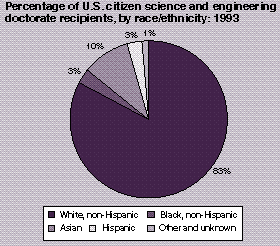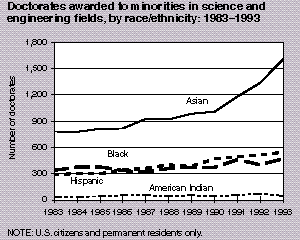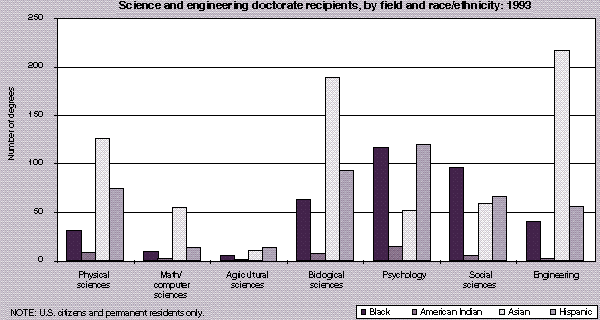statistics on the numbers
of Blacks receiving mathematics Ph.D.s since 1993
The data below comes from the National
Science Foundation. Also in pdf.
|
With the exception of Asians, minorities
are a small proportion of scientists and engineers in the United
States. Asians were 9 percent of scientists and engineers in
the United States in 1993, although they were only 3 percent
of the U.S. population. Blacks, Hispanics, and American Indians
as a group were 23 percent of the U.S. population but only 6
percent of the total science and engineering labor force.
Blacks and Hispanics were each about 3 percent, and American
Indians were less than 1 percent of scientists and engineers.
Within the doctoral science and engineering labor force, the
differences in representation of racial and ethnic groups are
greater than is the case within the science and engineering labor
force as a whole. Underrepresented minorities are an even smaller
proportion of doctoral scientists and engineers in the United
States than they are of bachelor's or master's scientists and
engineers. Asians were 11 percent of doctoral scientists and
engineers in the United States in 1993. Blacks were 2 percent,
Hispanics were 2 percent, and American Indians were less than
half of 1 percent of doctoral scientists and engineers.
|

|
|
Within the science and engineering
labor force as a whole, the distribution of minority scientists
and engineers by field differs depending on the minority group.
Asians are concentrated in engineering, in computer science,
and in the life and physical sciences. Black scientists and engineers
are disproportionately likely to be in the social sciences and
in computer science. Hispanics and American Indians do not differ
greatly from whites in terms of field.
Minority women, with the exception of Asian women, are similar
to white women in terms of field. Black and Hispanic women are
more likely than minority men to be in computer or mathematical
sciences and in social sciences and are less likely than minority
men to be in engineering. Asian women, although less likely than
men to be engineers, are more likely than other women to be engineers.
Asian women, like Asian men, are less likely than other women
to be social scientists.
|

|
Black and American Indian scientists and engineers are more
likely than white, Hispanic, or Asian scientists and engineers
to have a bachelor's as the terminal degree. For example, 66 percent
of black scientists and engineers in the U.S. labor force have
a bachelor's as the highest degree compared to 55 percent of all
scientists and engineers.
Among doctoral scientists and engineers, field differences
in employment follow the differences in field of doctorate noted
in chapter 4. Black doctoral scientists and engineers are concentrated
in the social sciences and are underrepresented in the physical
sciences and engineering. Half of black doctoral scientists and
engineers, but only 29 percent of all scientists and engineers,
are in the social sciences and psychology. Only 11 percent of
black doctoral scientists and engineers compared with 21 percent
of all doctoral scientists and engineers are in physical sciences,
and only 11 percent of black doctoral scientists and engineers,
compared with 16 percent of the total, are in engineering. Hispanic
doctoral scientists and engineers are similar to whites in terms
of field.
Asians are more likely than other doctoral scientists and engineers
to be in engineering and are less likely than other doctoral scientists
and engineers to be in social science. Thirty-seven percent of
Asians are in engineering, compared with 16 percent of all doctoral
scientists and engineers, and only 10 percent of Asians are social
scientists, including psychologists, compared with 29 percent
of all doctoral scientists and engineers.

Racial/ethnic groups differ in field of teaching and in academic
employment characteristics. They differ in the types of institutions
in which they teach, in employment status, in highest degree,
in research activities, in rank, and in tenure.
Blacks are underrepresented and Asians are overrepresented
among engineering faculty. Although blacks are 4 percent of science
faculty, they are only 2 percent of engineering faculty. Within
the sciences, black faculty are a higher proportion of social
science faculty (6 percent) than they are of other disciplines.
Asians are 15 percent of engineering faculty and 5 percent of
science faculty
The types of schools in which racial/ethnic groups teach differ.
Asian faculty are farless likely than other groups to be employed
in 2-year colleges. Black faculty are less likely than other groups
to be employed in research institutions and are more likely to
be employed in comprehensive institutions, liberal arts schools,
and 2-year colleges. Hispanic faculty are less likely than other
groups to be employed in research institutions and are more likely
to be employed in 2-year colleges.
Minority faculty also differ in research
activities. Asian science and
engineering faculty are far more likely than other groups to be
engaged in research and to prefer spending time doing research,
especially in the doctorate and comprehensive universities. They
are also more likely than others to be engaged in funded research,
to be principal or co-principal investigators , and to have published
within the last 2 years-at all ages and within research universities.
Black and Hispanic faculty differ little from white science
and engineering faculty in time spent in teaching or research
and in preferred time in teaching or research. Other than in Mathematics,
Black faculty, have fewer publications than white scientists and
engineers in the previous 2 years-at all ages and in all types
of schools. Black faculty are also less likely than other groups
to be engaged in funded research or to be a principal investigator
or co-principal investigator.
Differences in faculty rank and tenure among racial/ethnic
groups exist as well. Although Asians are not underrepresented
in science and engineering employment, as is the case with underrepresented
minorities, they are less likely to be full professors or to be
tenured. Among full-time ranked science and engineering faculty,
Asians, blacks, and Hispanics are less likely than whites to be
full professors. Forty-one percent of Asians, 33 percent of blacks,
and 45 percent of Hispanics, compared with 49 percent of whites,
are full professors. These differences are partly explained by
differences in age. Black, Hispanic, and Asian scientists and
engineers are younger on average than white and American Indian
scientists and engineers. When age differences are accounted for,
Asian and Hispanic faculty are as likely or more likely than white
faculty to be full professors, but black faculty are still less
likely than other faculty to be full professors. Among ranked
faculty who received doctorates 13 or more years previously, only
58 percent of black faculty compared to 70 percent of white faculty
were full professors.
Black, Hispanic, and Asian faculty are also less likely than
white faculty to be tenured., compared with 64 percent of white
faculty, are tenured. Black, Hispanic, and Asian faculty are more
likely than white faculty to be on a tenure track. Thirty percent
of black faculty, 48 percent of Hispanic faculty, and 27 percent
of Asian faculty, compared with 19 percent of white faculty, are
on a tenure track. Again, these tenure differences are likely
to be related to age differences.
A similar pattern of primary work activity is found among doctoral
scientists and engineers. Black and Hispanic doctoral scientists
and engineers employed in business or industry have primary work
activities similar to white doctoral scientists and engineers.
Asians, on the other hand, are much more likely than other groups
to be in research and development.
An analysis of the differences in average salaries among racial/ethnic
groups was performed analogous to that done for the gender salary
gap among full-time employed science and engineering doctorate-holders.
Because of the relatively small number of individuals within some
of the racial/ethnic groups, the results are necessarily more
tentative than was the case for the gender salary gap.
The salary differences between whites and the racial/ethnic
minority groups are not as large as the gender salary gap. The
differences range from $4,100 for Asians to $7,100 for blacks.
Although smaller than the $13,300 gender gap, these are not trivial
differences and rightly raise the question of the extent to which
these differences can be accounted for by other variables in a
manner analogous to that done for the gender salary gap.
The background variables, including years since receipt of
the doctorate and field of degree, explain substantial parts of
the observed black/white and Hispanic/white salary gaps (35 percent
and 33 percent, respectively). Adding the remaining work-related
and life-choice variables to the analysis explains the remaining
racial/ethnic salary gaps for blacks and Hispanics.
The analysis of the Asian/white gap shows a very different
pattern than that for blacks and Hispanics. Field of degree has
a strong "negative" explanatory effect on the salary
gap. This indicates that when Asians and whites are statistically
"equalized" on field of degree, the resulting salary
gap is larger than the observed gap. This is attributable to the
fact that Asians are concentrated in degree fields such as engineering
that have relatively high salary levels. Employer characteristics
also have a strongly negative explanatory effect. This effect
largely results from Asians being relatively more likely to be
employed in the private sector (47 percent of Asians are so employed
compared with 29 percent of whites). After statistically equalizing
Asians and whites on all variables in the analysis, the "unexplained"
salary gap between Asians and whites is approximately $900 (23
percent of the observed gap).
The salary gap for American Indians and whites shows an explanatory
pattern that is different from the other groups examined. The
data do not indicate that American Indians have been increasing
their participation in the doctoral labor force over time. Therefore,
years since doctorate is not an important factor in explaining
the salary gap between American Indians and whites. All of the
variables combined explain approximately 57 percent of the $6,500
salary gap. Thus, approximately 43 percent of the observed gap
remains unexplained. For American Indians, this constitutes approximately
$2,800. The reader is cautioned, however, that the number of American
Indians in the sample is quite small and that these estimates
must be considered fairly imprecise.
Before leaving the topic of racial/ethnic salary differences,
it is interesting to look at whether significant "unexplained"
racial/ethnic salary gaps are evident when one looks separately
at U.S.-born and non-U.S.-born individuals, since a disproportionately
high percentage of minority group members in the doctoral population
are born outside the United States and the decomposition of the
salary gaps for U.S.-born individuals could be quite different
than for those born outside of this country. Examination of the
data indicates that for U.S.-born individuals, the variables examined
"explain" all or almost all of the observed racial/ethnic
salary gaps for all the groups examined except for American Indians.
In fact, U.S.-born blacks and Asians have higher average salaries
than would be expected, given the different racial/ethnic group
characteristics on the variables examined, when compared with
whites.
The relatively high salaries of U.S.-born blacks and Asians
may, of course, be the result of imperfections in the model used
in this analysis. It is possible, for example, that the obstacles
placed in the way of minority entry into the doctoral science
and engineering labor force result in those minority members who
are successful being more qualified than whites on factors, such
as "willingness to work hard," that we were unable to
measure. Alternately, the relatively high salaries of U.S.-born
blacks and Asians may indicate that employers have a preference
for U.S.-born blacks and Asians-perhaps in response to affirmative
action programs.
Among the non-U.S.-born, Hispanics have similar salaries to
whites with similar characteristics; however, approximately $2,300
of the Asian/white and black/white gaps remain unexplained.
In sum, these data do not indicate that racial/ethnic status
has much effect on salary within this very "elite" population
of full-time-employed individuals with doctoral science and engineering
degrees when one compares groups with similar characteristics
on relevant variables. After adjusting for differences in work-related
characteristics, the only U.S.-born minority group with an average
salary substantially lower than that of U.S.-born whites was American
Indians. Because the sample contains few American Indians, however,
this result may be attributable to sampling variability. For U.S.-born
blacks and Asians, minority group salaries are actually somewhat
higher than would be expected on the basis of the characteristics
adjusted for in this analysis.
Statistics on the Undergraduate
Mathematics Major 1980-2000
7.69% of math majors with Bachelors get the
Ph.D. in Mathematics within the next 6 years.
|
Percentage of Freshman Intending
to Major in Mathematics |
|
ETHNIC GROUP |
1985 |
1990 |
1995 |
2000 |
|
WHITE |
1.1% |
0.9% |
0.7% |
0.7% |
|
BLACK |
0.7% |
0.5% |
0.7% |
0.5% |
reference: undergrad1980-2000
Back to Mathematicians of the African
Diaspora



